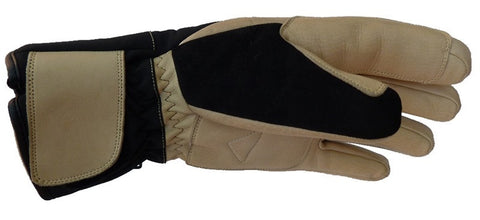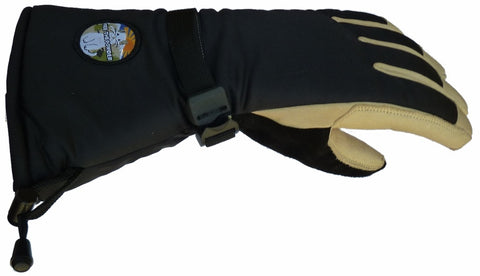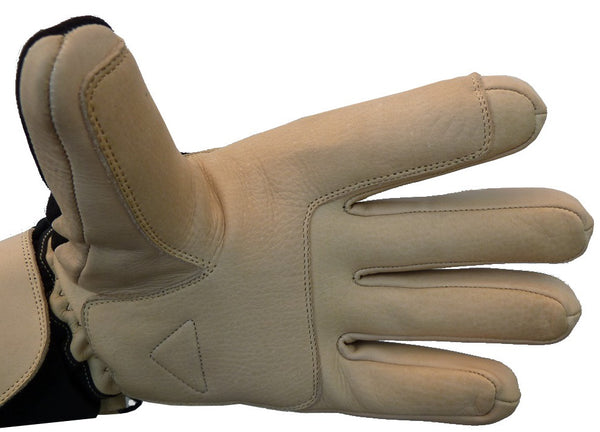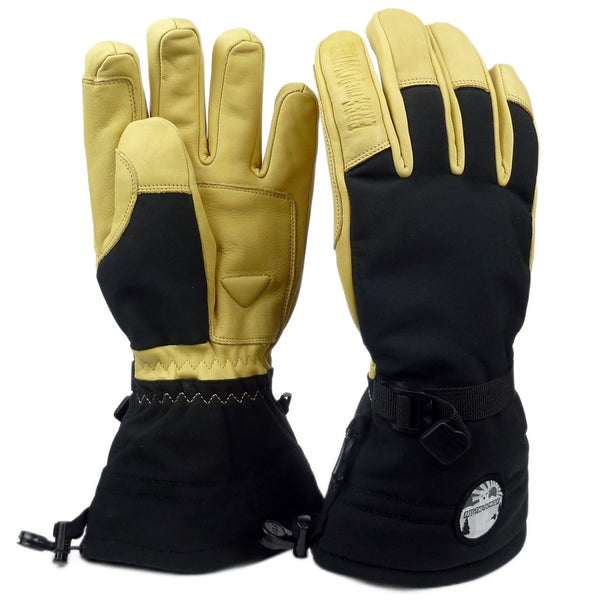Guide to Backcountry Ski Gloves
"BACKCOUNTRY"
It's the buzzword that gets everybody's attention in the world of skiing and snowboarding. It's cool. It's adventurous. It's "extreme". But not so long ago, being a backcountry skier and rider meant you were some oddity that had no job, or only worked nights or in the summer. You were an unshaven, long-haired weirdo, a granola-chomping hippie with questionable hygiene. These were the glory days of duct tape on every seam of backcountry ski gloves and mittens. The Age of the Dirtbag!

Not anymore.
Today, it seems like every high-rolling investment banker, lawyer, doctor, average ski town Joe, and high school kid is now a backcountry skier or rider. This explosion in popularity has spawned a huge industry of "backcountry" and "sidecountry" products, including a dizzying array of expensive gloves and mittens.
There are two main styles for backcountry ski gloves and mittens: Short-cuff (that fit under the cuff or sleeve of your jacket) or Long-cuff (Gauntlet-Style with forearm closures that fit over the cuff or sleeve of your jacket).


Having spent more than 3000 days in my life backcountry skiing and climbing, I will tell you what I think works best for a day-use backcountry mitten and ski glove. (Multi-day use is a whole 'nother animal). The choice of hand protection in the backcountry is obviously very personal, and many people employ multiple pairs with different characteristics depending on the conditions. This guide is for the backcountry skier and rider who only wants to buy one pair of gloves or mittens that works best for most days and most conditions.
1. Which style? I do not like having to carry a spare pair of gloves or mittens for day trips in the backcountry, so that leaves me with two options: a glove or mitten that floats between too warm and just right OR a glove or mitten that floats between too cold and just right. Most days in the backcountry usually start cold, and get warmer as the day progresses. You pick your poison with most mittens and gloves. ALWAYS CHOOSE THE WARM. You can always take the gloves or mittens off and stick them on the ends of your poles when hiking. Short-cuff mittens are not as easy to stick on your pole grips because they are designed with an "automatic" wristband closure of stretchy material. Long-cuff Gauntlet-style gloves or mittens are designed to give you a choice between open and closed. That gives you the ability to regulate the temperature of your hands.
2. Removable liners, or not? Removable liners can be a big help (and probably essential for a multi-day backcountry outing). The liners can be used by themselves as an effective second pair of mittens/gloves. They also dry faster when separated. The problem with removable liners is that they are often quite difficult to re-seat in the correct position inside the shell. Personally, I have had some fiasco's trying to put the shell and liner back together when one or both are cold, wet, sweaty, you-name-it. That's less of a problem with mittens, but gloves can be a crap shoot, depending on the design of the glove. When you try them on at the store, make sure they come apart and go back together really easily, because when you're out in the elements it ain't gonna be so easy. To each his own and I know people have differing views, but the fundamental problem with removable liners that often cannot be avoided is that the gloves or mittens rarely fit properly together. Dexterity is often decreased because the liner is not fixed - it moves relative to the shell every time you move your hands (which is constant). I know of what I speak as I wore them for years and have a giant pile of them in my basement. But there is a unique solution that Free the Powder Gloves solved in our new RX and SX models: a removable liner glove that goes in and out of the shell with just the right amount of friction between the liner and shell that makes them easy to insert and remove but remain firmly fixed when inserted.
3. Dexterity: Gloves are much better for dexterity, but give away warmth, which gives a mitten more versatility on cold days. Dexterity can be achieved in a mitten if you choose one size smaller than you would normally wear in a glove. Read our analysis of ski glove dexterity
4. Grip: The grippiness of a glove or mitten is created primarily by the surface of the palm. Sometimes grip patches, common in work gloves, are helpful, but in my experience they are mostly cosmetic. Natural leather has the best grip, and the real secret is in the tanning of the leather. Free the Powder makes the grippiest gloves on the market, due to our process of emulsion in fatliquors. Learn more about the tanning process of leather
5. Mittens or Gloves? Mittens give away dexterity but will typically be warmer than a glove. Your fingers together retain a lot more heat, but that can also mean sweat for some people. Having more air around your fingers allows for better circulation and breathability. I have poor circulation in my extremities so mittens are a better one-glove solution for me. It really is up to the individual though. If your hands rarely get cold and dexterity is a priority for you, then gloves are the way to go. Helpful advice on choosing mittens or gloves
6. Water-proof membrane, or not? This is a tough question because the answer changes depending on temperature, wetness of the environment, and especially activity level. If you're using the glove or mitten during low activity levels or when it's really wet, then water-proof membranes can be really nice. The membrane keeps most of the wetness out, while the low activity level keeps the hand from creating its own moisture through sweat. Forget the hype: Gore-Tex® and every other water-proof membrane are essentially plastic bag liners that keep the water out, but also keep the water in. Even the best of them are much less breathable than a no-membrane glove or mitten. Once wet inside, membrane gloves and mittens are very slow to dry. Backcountry skiing and riding throws a bit of a wrench into this question, because it depends on the activity. If strenuous hiking and skiing is your game, then breathability is by far the most important variable to consider, and for you water-proof membranes may not be all they're cracked up to be. But if you are ice climbing or heading out onto a tour that may include rain, then a water-proof membrane is probably important.
As a backcountry ski glove designer, I spent an entire ski season (100+ days) wearing a membrane glove on one hand and a non-membrane glove on the other. The rest of the design characteristics were exactly the same. Most of the time the membrane caused clammy hands, whereas the non-membrane glove was almost always dry. On the days when it was raining, both gloves were saturated with water. The membrane glove was much slower to dry once saturated. For me and my team of testers, the membranes were less effective than the no-membrane option.
Someday, when we find a "waterproof-breathable" membrane insert that works to our satisfaction, we will offer them in our gloves. Learn more about water-proofing of ski gloves
7. Type of leather, treatment and re-enforcement patch: Climbing skins are absolutely brutal on the palms of gloves and mittens, as are rocks, ice, and climbing tools. LEATHER palms are essential. But not all leather palms are created equal: the quality of the leather and the placement of the re-enforcement patch are essential.

Three types of leathers are most common: cowhide, goatskin, and deerskin. There are always exceptions based on their treatment, thickness and quality, but in GENERAL:
· Deerskin (usually shiny yellow colored) is the softest and most dexterous, but it gives away significant toughness due to its thinness.
· Goatskin is tougher, but a little less soft and dexterous than deerskin. It's a good balance and is very popular.
· Cowhide is by far the toughest, but often gives away a bit of softness and dexterity. The range of thickness and quality varies greatly.
More important than what animal the hide came from, is what type of tanning process it went through when it was made and how thick the leather is. See our Guide to Leather Ski Gloves
Free the Powder uses premium cowhide leather that is a bit thicker. Our leather uses a unique tanning process to maximize grip and toughness, while maintaining the highest possible softness and dexterity. We then put a cowhide leather reinforcement patch over the already tough cowhide leather palm.
To maintain the performance and durability of leather gloves you will need to treat them regularly with leather conditioner/dressing so the leather does not become dry and weak. Learn more about leather care
For the rigors of backcountry skiing, the reinforcement patch on the palms is very important. The reinforcement needs to protect all the high wear areas of the palm: TOTAL PROTECTION FOR THE MIDDLE OF THE THUMB, EXTENDING ACROSS THE BRIDGE OF YOUR HAND, AND ALL THE WAY UP YOUR INDEX FINGER. Learn more about our reinforcement patch.

Why Free the Powder?
-
Premium Quality
We use the best quality leather and the most breathable materials in order to make the warmest and toughest ski gloves and mittens.
-
Superior Value
Why pay a triple digit markup for quality? We sell our premium leather ski gloves direct at lower prices than our competitors.
-
Free Fast Shipping
No one wants to wait for their order to ship. You'll get your gloves and mittens fast! We get your order out to you ASAP.
